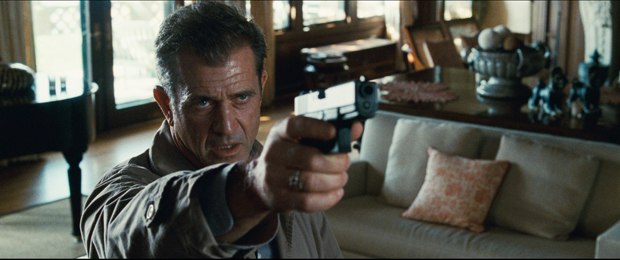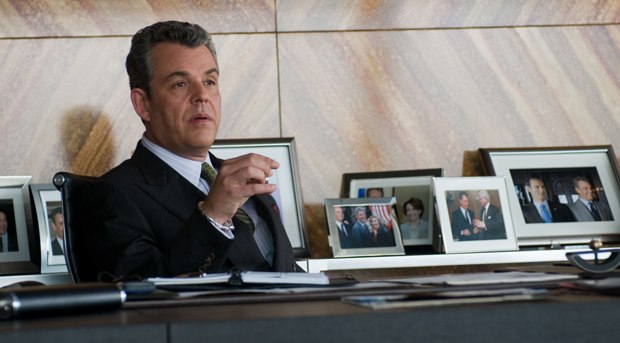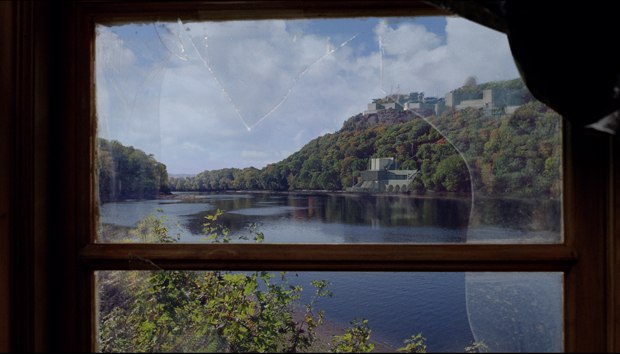Kent Houston of Peerless Camera discusses some nifty gore and environments in the return of Mel Gibson in front of the camera.
Check out the Edge of Darkness trailer at AWNtv!
Edge of Darkness is noteworthy not only for Mel Gibson's return to acting after directing Apocalypto and The Passion of the Christ, but also for Martin Campbell coming full circle after his breakout direction of the acclaimed '85 miniseries.
Kent Houston of Peerless Camera has collaborated with Campbell for a decade and found this experience perhaps a little more personal for the director, who labored for years to make a feature-length version of this powerful story about a police detective investigating the murder of his daughter and uncovering enviro-terrorism in the process. But, like The Lovely Bones, the heart of the movie is about a grief stricken father tragically getting closer to his daughter in death.
Transplanted from Britain to Boston, the opening packs a wallop, as we witness the slaying of Emma Craven (Bojana Novakovic) on her father's front doorstep (Gibson plays Craven).
"The murder of the daughter was a combination of practical and CG," Houston explains. "They had the girl in a cable and pulled her very hard through the door. And to allow the cable to exit her back and the door to fly open, the door has a section missing in the raw footage and has been rebuilt in Maya and the glass is replaced. All the flying glass is CG; and the glass that lands on the floor is partly real and partly CG. And there's quite a bit of harness and cable removal work.
"The blood is a mixture of some practical and then some put on in post. What we did for the blood is actually painted. We used Curious paint for that, which is then tracked on. The glass on that was Maya. And the comping for those particular shots was done with Shake. For comping, most of the show was done with Flame and Inferno.
In fact, there is a lot of blood in the movie: "Martin is quite gory," adds the visual effects supervisor. "There's quite another interesting shot, which is when her nose first starts to bleed at her dad's house, and that is CG blood coming out of her nose and on her finger. It was XSI for the nose and the stuff for the finger is actually, again, Curious paint and then tracked on."
Later on, there is another horrifying assassination of a woman after she's interrogated by Craven in his car. This too was a combination of practical and CG involving a real stunt person, a dummy and the actress (Caterina Scorsone) joined together.
"It's pretty powerful and what Gary Powell, the stunt supervisor, did was he blocked it out on video and then we figured out which bits we'd do for real and where the takeovers would be and what all the camera angles would be," Houston continues. "And a lot of the shattered glass is CG. We had to pose the dummy in the exact same position as the actress as she exited the car and that was done on the day with video assist. It was a little tricky but KNB did the dummy.
"After the girl is hit by the car, Gibson shoots the driver and the car slams into a tree stump and falls into the river. To help that stunt, there was a skid plate on the other side of the car to help it get a good launch into the air and we got great coverage, but the car obviously rolls and you see the other side, so that is all rebuilt in CG when you see the underneath of the car and track back in and that would've been Maya."
Toward the end of the movie, when Craven shoots a body guard with his hand up, what actually happens in that shot, according to Houston, is that the bullet passes through the guy's forefinger, blows it off and it goes on through his eye. "We did that, again, mainly with Curious paint and Shake and a CG finger tumbling out of frame -- it's all very fast. But it's pretty gory."
And then with some pinpoint gunshots, the bullet holes were actually put on by makeup at the start of the take and "basically what we've done is paint them out until the point of impacts have to appear, so it's safer to track individual bullet holes onto peoples' heads and there's a tiny, little bit of paint work for those little specs of blood, but quite restrained, really."
As for environments, the most noticeable vfx is Northmore, the mysterious nuclear facility, which is a combination of matte paintings and miniatures. "And the miniatures were built by the art department in Boston and we shot them in a car park outside the stage and they were in-house with some matte paintings and some real photography of satellite tracking aerials. The actual environment is made up of three different live-action plates: one of a river, one of a hill and another of some distant hills. And when you see that for the first time, it's actually through a window of an old, derelict summer house, and that summer house is a bluescreen element.
"When the daughter is doing her video to her dad, that was a piece of set that had been transported from Boston to Los Angeles and was shot against a white backing because they felt they wanted the windows to be burnt out and then later they decided they wanted to get the feeling that that was in the location of the Northmore complex, so we then had to put that composite image behind her. Because it wasn't shot for that, it was quite tricky but it seems to work fine."
Finally, there was some there is some 2D work involved in a very powerful dream sequence. "There was a plan originally to shoot that over cranked so they're in slow motion," Houston explains. "Then on the day we shot it, we decided it was going to be normal speed, but once they cut it, they decided to have [the main characters] be in slo-mo and everyone to be at normal speed. Of course, it hadn't been shot for that so what we had to do was isolate them with roto, vary speed down to the equivalent of 48 frames, restore everybody back in the right places, either over them or behind them. It was quite complex because the camera's moving throughout that shot and it was a real pain to do it."
Bill Desowitz is senior editor of AWN & VFXWorld.











